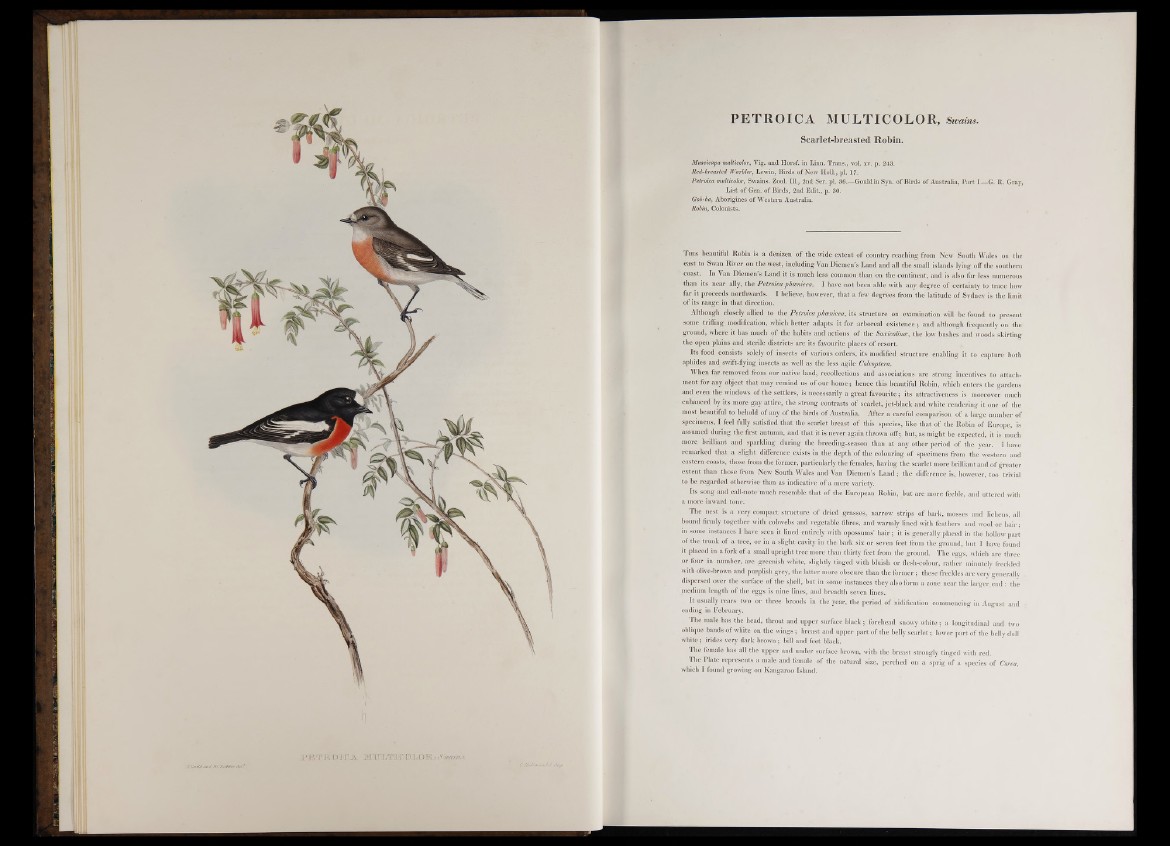
PETROICA MULTICOLOR, Swains.
Scarlet-breasted Robin.
Muscicapa multicolor, Vig. and Horsf. in Linn. Trans., vol. xv. p. 243.
Red-breasted Warbler, Lewin, Birds of New Holl., pi. 17.
Petroica multicolor, Swains. Zool. 111., 2nd Ser. pi. 36.—Gould in Syn. of Birds of Australia, Part I.—G. R. Gray,
List of Gen. of Birds, 2nd Edit., p. 30.
Goo-ba, Aborigines of Western Australia.
Robin, Colonists.
T his beautiful Robin is a denizen of the wide extent of country reaching from New South Wales on the
east to Swan River on the west, including Van Diemen’s Land and all the small islands lying off the southern
coast. In Van Diemen’s Land it is much less common than on the continent, and is also far less numerous
than its near ally, the Petroica phcenicea. I have not been able with any degree of certainty to trace how
far it proceeds northwards. I believe, however, that a few degrees from the latitude of Sydney is the limit
o f its range in that direction.
Although closely allied to the Petroica phcenicea, its structure on examination will be found to present
some trifling modification, which better adapts it for arboreal existence ; and although frequently on the
ground, where it has much o f the habits and actions o f the Saoeicolinas, the low bushes and woods skirting
the open plains and sterile districts are its favourite places o f resort.
Its food consists solely o f insects of various orders, its modified structure enabling it to capture both
aphides and swift-flying insects as well as the less agile Coleóptera.
When far removed from our native land, recollections and ássociations are strong incentives to attachment
for any object that may remind us o f our home; hence this beautiful Robin, which enters the gardens
and even the windows o f the settlers, is necessarily a great favourite; its attractiveness is moreover much
enhanced by its more gay attire, the strong contrasts of scarlet, jet-black and white rendering it one o f the
most beautiful to behold o f any of the birds of Australia. After a careful comparison o f a large number of
specimens, I feel fully satisfied that the scarlet breast o f this species, like that o f the Robin o f Europe, is
assumed during the first autumn, and that it is never again thrown off; but, as might be expected, it is much
more brilliant and sparkling during the breeding-season than at any other period o f the year. I have
remarked that a slight difference exists in the depth of the colouring o f specimens from the western and
eastern coasts, those from the former, particularly the females, having the scarlet more brilliant and o f greater
extent than those from New South Wales and Van Diemen’s Land; the difference is, however, too trivial
to be regarded otherwise than as indicative of a mere variety.
Its song and call-note much resemble that o f the European Robin, but are more feeble, and uttered with
a more inward tone.
The nest is a very compact structure o f dried grasses, narrow strips of bark, mosses and lichens, all
bound firmly together with cobwebs and vegetable fibres, and warmly lined with feathers and wool or hair;
in some instances I have seen it lined entirely with opossums’ hair; it is generally placed in the hollow part
of the trunk of a tree, or in a slight cavity in the bark six or seven feet from the ground, but I have found
it placed in a fork of a small upright tree more than thirty feet from the ground. The eggs, which are three
or four in number, are greenish white, slightly tinged with bluish or flesh-colour, rather minutely freckled
with olive-brown and purplish grey, the latter more obscure than the former; these freckles are very generally
dispersed over the surface o f the shell, but in some instances they also form a zone near the larger end : the
medium length o f the eggs is nine lines, and breadth seven lines.
It usually rears two or three broods in the year, the period of hidification commencing in August and
ending in February.
The male has the head, throat and upper surface black; forehead snowy white; a longitudinal and two
oblique bands o f white on the wings; breast and upper part o f the belly scarlet; lower part o f the belly dull
white; irides very dark brown; bill and feet black.
The female has all the upper and under surface brown, with the breast strongly tinged with red.
The Plate represents a male and female of the natural size, perched on a sprig o f a species o f Corea,
which I found growing on Kangaroo Island.